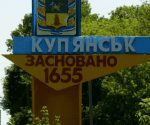While AFU resorts to using cars and Mi7 propaganda projects other terminal Ukrainian weakness, Russia continues to take Donetsk
Your alternative media, reader, might not be telling you this, but for several days in October (now consistently heading into November), in its daily briefings the Russian Ministry of Defence is having cause to report on a new particular type of Ukrainian casualty. It appears that the Ukrainians are utilising civilian road cars as troop transports in their attacking manoeuvres, and inevitably they are showing up in Russian lists. At the foot of the page can be found numerous such examples as featured in a number of extracts from Russian MoD briefings from 19th October (when the phenomenon was first noticed by the author) and onwards: in total, 173 cars (or if one wants to insist on precision, 91, along with 82 “motor vehicles”) have been “eliminated” over the course of 13 days.
The development, of course, is proof of a shortage of dedicated armoured personnel carriers, and also the devastating effectiveness of the Russian operation to demilitarise Ukraine. According to Wikipedia, which lists Ukrainian military assets in their pristine condition as if there never had been any conflict, the Armed Forces of Ukraine (AFU) have had thousands of tracked armoured personnel carriers, and slightly less wheeled armoured personnel carriers and infantry mobility vehicles – the more exact numbers are coming up – but it now appears this multitude of purpose-built troop transport is not available. Look again at the lists below, reader, and note that only 10 instances of armoured personnel carrier are mentioned. Is it any wonder, therefore, that featuring in the latest package of assistance, largely free of “wunderwaffe”, from the US to Ukraine are 125 Humvees? Whether they be of an armoured or unarmoured variety is unknown. Also unknown is whether or not these are a delivery of already promised vehicles. In any case, Wikipedia reports that the Ukrainians will have had more than 600 of these from the Americans.
There can be no mistake that the Russians mean that they are destroying cars when the term is used in their reportage. Less unequivocal is the term “motor vehicle” (or, simply, “vehicle”), which – in truth – the Russians have been using long before now with the inference being that this was equipment definitely without armour or weaponry, and perhaps not even militarily dedicated. One thing is for sure, the term “motor vehicle” does not refer to pickup trucks, which is a term separately used, or miscellaneous military vehicle, such as “combat vehicles”, or “special motor vehicles”, both terms used previously. There is good reason to understand that this has always potentially referred to ad-hoc troop transportation.
There’s confirmation from the other side that certain Ukrainians have viewed civilian motor vehicles as desirable assets. A Guardian article of April 2022 seems to suggest that “cars, pickup trucks and SUVs” from the UK and Europe got sent straight to the front lines “to where Ukraine’s forces are most in need”, while a Business Insider piece of June 2022 reports on a customisation operation in Lvov, where the favoured models for refitting (with “armour” and even some kind of weapon) are “the Toyota Hilux/Tundra, Mitsubishi L200, Ford Ranger, Nissan Navara/KingCab, Isuzu D-Max, Маzda BT-50/Mazda B2500, and the Jeep Gladiator.”
However, as plucky as this all seems, when one reads the fantasy from the same said Business Insider article of the sort that follows, having had it explained that fitting a car with armour involves applying a sheet of metal to the chassis, one understands exactly that one is looking at “all-in-it-together-never-surrender” propaganda:
Truck models that you [would] see parked on the street or being driven to the shopping mall are transformed into vehicles capable of, and ready to attack Russian tanks.
In actual fact, other Ukrainians not involved in what must essentially be a racket must know as well as anyone else that using a car in any fighting against the most effective weapons systems on the planet – even if they do have a sheet of steel in the footwell – is an act of utmost futility, and a thing never meant outside the bounds of make-believe to lift Ukrainian spirits and help the second-hand car dealer chums of UK politicians make a literal killing. And yet, necessity appears to dictate this preposterousness become a real thing, and there’s even visual confirmation.
The images below were actually posted online on 13th October, and show a Lancet drone attacking what looks like a people carrier. The footage also shows a minibus – or larger troop transport – parked in the background (source).
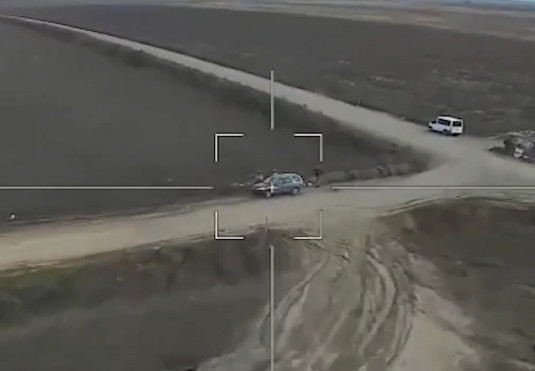 |
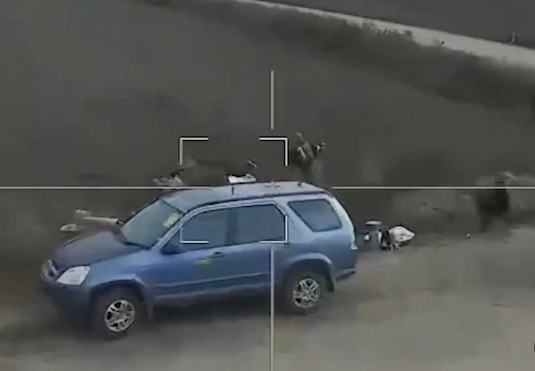 |
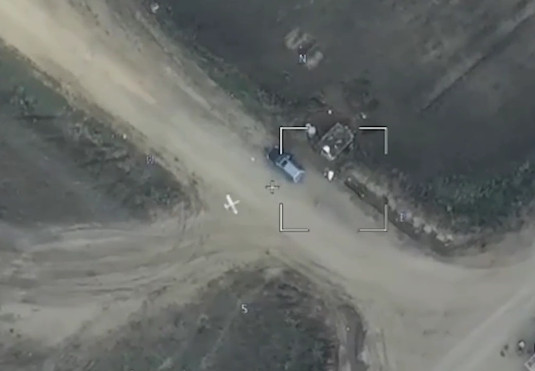 |
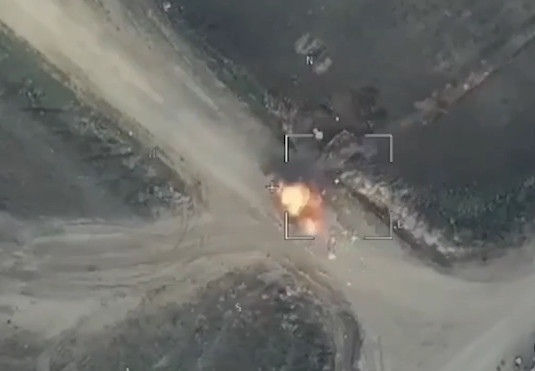 |
Of course, all of this is completely consistent with the picture of the Special Military Operation – in its current phase, it has to be said, ahead of an anticipated major Russian offensive – that has become quite clear where, in the face of the enormous advantage had by the Russians, there is a trade off in Ukrainian conduct between sensationalism for propaganda and quite disgusting casualty incidence and incidents.
It is constant subject matter at FBEL, and there is no intention to go all over it again here, but because something brief must be said: because the Ukrainians cannot win this conflict, they have been hanging on for the occurring of the great miracle hoped for by their UK/US masters, which is political turmoil in Moscow that leads to Russia ceasing its operation. This is never going to happen, but Ukraine is told to persist nevertheless. Conducive to this has been high morale obtained by headline-grabbing winning of blue-map (denoting territory “re-conquered”), which takes advantage of Russian willingness to allow the Ukrainians to present themselves as targets (for the purpose of demilitarisation), and involves a Human Wave tactic that is basically about trying to achieve a position before being wiped out doing it. There’s further explanation of why this approach has suited the Ukrainians in the article entitled The “Unification Spoiling” Grand Public Relations Operation At Krasny Liman (and, in other articles, plenty of demonstration of the Ukrainians employing it [search “Human Wave”] ), but the thing to understand at this juncture is that it is an approach that is not sustainable – and the fact that the Ukrainians are operating cars when they did have thousands of armoured personnel vehicles is testament to it.
Soviet legacy MT-LBs (translated as “light armoured multi-purpose towing vehicle”) are tracked APCs, and the Ukrainians had about 7000 of various varieties. Other vehicles of this general type were supplied by the US, UK, the Netherlands, Poland and Lithuania, with the former two countries evidently having supplied around 400, and the latter three sending an undisclosed amount. Apparently, the Ukrainians claim to have captured 40 and more of this classification from the Russians. As for wheeled APCs, the Ukrainians had about 1000, with infantry mobility vehicles (of which the Humvee is a type) numbering at about 2000. The total is an amount of something like 10,000 dedicated vehicles. The Russians say they have destroyed 6,213 “tanks and other armoured combat vehicles”, and 6,920 “units of special military equipment”. It is also to be recalled that the MT-LBs are from the 1950s and were considered in need of upgrading – it is not clear that the whole fleet has been available to the Ukrainians, especially as Wikipedia reports that the Ukrainians have used them after customisation to carry a field artillery gun. This could mean not very many.
Running a parallel course to the issue of unfathomable loss of Ukrainian materiel is the catastrophic loss of Ukrainian manpower, as indicated by another round of mobilisation decreed in October by which all men under the age of 60 will soon have to “reckon with a summons”. Yuriy Maksymov,“chief military commissar in Kiev”, was being interviewed on TV, and told of tension regarding personnel levels, and the urgent need to strengthen them. However, it wasn’t clear how this situation could be reconciled with Maksymov’s declaration that “we are now at the highest level of mobilization”. There has long been talk of older men than should be in the ranks of Ukraine’s army. Moreover, while Zelensky was last month signing voluntary registration of women for military service into law, an actual prisoner exchange in October saw 96 females already in Ukrainian military service swapped for mostly civilian sailors. It very much appears that it only remains for the Ukrainians to conscript women and pensioners for the entire country to be under arms, and crucially not to reinforce, but to replace (a dismal state of affairs on the eve of what the Russians must do next).
Notably this week the Russian Tass news agency did what Mi7 (UK corporate-media) would do if it was real journalism (and did what the author hasn’t yet seen it do) and ventured into reporting on the Russian Ministry of Defence’s casualty figures for Ukrainian forces. At 2,500 dead (including foreign fighters) for the seven days of 24th to 30th October, this was one and a half more than the previous week: the point was probably to highlight an acceleration in what was already an astonishing rate of recurrence.
The cause, as always, is that the UK/US in its leadership of Ukraine is doing the only thing that it can do except surrender as Russian partial mobilisation has effected the battlefield and come to act in defence (before it attacks) like the dead weight in those coin cascade arcade games so that no amount of new metal introduced is able overcome the inertia to cause a win.
Some alternative media so-called geopolitical experts tell their audiences that the Ukrainian desperation which is currently so manically self-destructive comes from having the Ukrainians get results in time for American elections (and even that Russia is timing her own action for the same), but it is nonsense. The UK/US leadership of Ukraine is merely suffering from the madness that comes from being convinced of its own infallibility, and so when Zelensky is reported (uncritically) in The Telegraph at the end of October telling of the “craziness of the Russian command” because of the way there has been fighting for Bakhmut (Artyomovsk) for months, and how, as the accusation goes “day after day, for months, they are driving people to their deaths there”, he’s not really talking about the Russians, and he’s not really talking about Bakhmut.
In the same vein, The Telegraph’s “senior reporter and history correspondent” who goes by the name of Daniel Capurro would expand the basic premise of Russians being driven to their death over an obsession with capturing Bakhmut to a point of perversion that Winston Smith would be proud of by describing the Russian methodology as a “human wave”: “deeply callous” “tactics from another age”. Of course, in actual fact the Russians are attacking the Ukrainians in the said town – as in any town currently being or soon to be liberated in Donetsk – by standoff firepower, and then with mobile units approaching enemy positions to test their resolve and remove them if they haven’t yet had enough. Nothing could be further from a Human Wave. Again, what this intelligence operative at The Telegraph has done is project the desperate Ukrainian experience on to the Russians, and in a way that could not be more revealing. Look at just what this Capurro character writes:
Where human wave attacks have previously been used – the Soviets at Stalingrad, China in the Korean War, Iran against Iraq, and Ethiopia in its war with Eritrea – booming demographics and widespread poverty meant that human life was cheap while materiel was expensive.
Russia is not in that position. Its population, especially of working age, is contracting sharply, made worse by a mass exodus due to the war. Every man killed is a catastrophe for Russian society, let alone its faltering army.
As Shoigu said when the partial mobilisation started, Russia is using a fraction of its manpower capability. This Mi7 operative is in fact writing about Ukraine’s condition: its army is faltering, and the barbaric suicidal sacrifice for blue-map has been catastrophic for its society.
Besides which, although Capurro quotes the pro-Ukrainian Institute for the Study of War as it claimed “Moscow’s forces ‘are likely falsifying claims of advances in the Bakhmut area to portray themselves as making gains in at least one sector’”, Russian armed forces are in fact not faltering all along the line in Donetsk, and gradually making progress towards its liberation: please see the map below which incorporates the Ukrainian admission that Russia’s actual offensive in Donetsk is certainly unrelenting (if that is what Zelensky actually meant) if not steady in its forward motion.
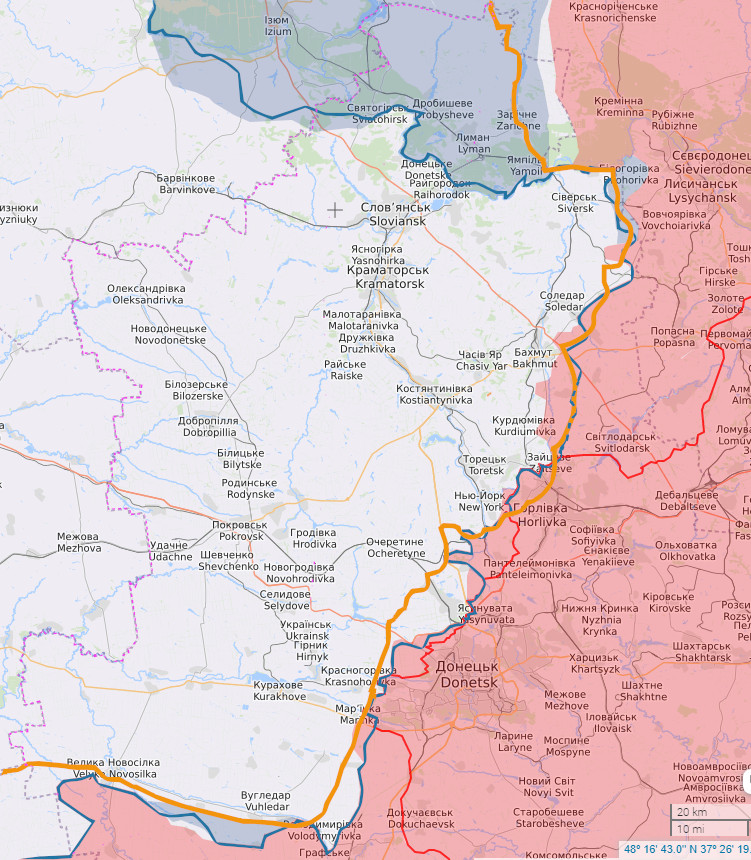
A Liveuamap dated 28th October, with enhancement. The blue line represents Russian positions as reckoned by the same mappers on 31st August. The thick orange line is Russian control reckoned by Russian Ministry of Defence map of 27th October. The western Donetsk border is accentuated by a dotted mauve line.
When considering the map the author’s advice to the reader is that, whatever the twaterati OSINT-mongery on social media are claiming from the ground, it is official (as far as the Russian information goes) and also biased towards the Ukrainians, and so for different reasons probably understates Russia’s encroachment into the territory of Donetsk. Frankly, the Russian MoD has been misdirecting its audience (as one might expect it to do if it wants to maintain some operational secrecy), and as this site has shown, has regularly claimed a lot less territory in the north than the Ukrainians would allow. This has somewhat been rectified in this latest map shown here, and in an act that goes along the same lines, the Russian Ministry of Defence announced† on 30th October that an advance had been made in the south of the region/republic so that, as far as the author could reckon, the Russians merely began to acknowledge their map as it had looked for a little while.
The following are extracts from Russian Ministry of Defence daily briefings, and do not constitute the full extent of Ukrainian casualties for the particular day.
19th October:
At Krasny Liman direction, the Russian troops successfully impeded the enemy’s efforts to cross the Zherebets River at night close to the settlements of Stelmakhovka, Rozovka, and Raygorodka of the Lugansk People’s Republic.
The Russian troops eliminated more than 30 Ukrainian personnel, three armored fighting vehicles, and two cars.
At Nikolayev–Krivoy Rog direction, the Russian Aerospace Forces conducted missile strikes to engage units of 60th Infantry Brigade and 35th Marine Infantry Brigade of the AFU, as well as units of Foreign Legion close to the city of Nikolayev and the settlements of Novovoskresenskoye, Bezymennoye, and Trifonovka in Kherson region.
In 24 hours, over 120 Ukrainian personnel and mercenaries, eight armoured fighting vehicles, and 12 cars have been neutralised.
21st October:
At Nykolayev–Krivoy Rog direction, Russian troops foiled two offensive attempts of AFU battalion tactical group close to Davydov Brod and Sukhoi Stavka in Kherson region.
Attempts of up to twenty AFU sabotage and reconnaissance formations to enter the rear regions at night were also foiled.
The concentrated fire of Russian artillery and the active actions of Russian troops neutralised more than 120 Ukrainian servicemen, six armoured fighting vehicles, and 13 cars.
22nd October
In the Kupyansk direction, the enemy made a failed attempt to launch an offensive against Kuzemovka (Lugansk People’s Republic).
More than 20 personnel, one tank, one armoured personnel carrier, and three cars were annihilated by Russian troops when they repelled the attack.
In the South-Donetsk direction, the enemy forces of two company tactical units attacked the positions of Russian troops in the direction of Balka Solenaya and heights near Vremevka.
The enemy suffered losses of 25 Ukrainian personnel, two tanks, three infantry combat vehicles, and two cars before being scattered by artillery fire.
In the Nikolayev–Krivoy Rog direction, the enemy attempted to breach the Russian troops’ defences by sending up to two battalion tactical groups in the direction of Pyatikhatki, Sukhanovo, Sablukovka, Bezvodnoye, Bruskinskoye, and Pravdino (Kherson region).
The Russian troops successfully repulsed all the attacks, the enemy was driven back to their original positions. More than 130 Ukrainian personnel, two tanks, nine armoured fighting vehicles, and 13 cars were neutralised.
23rd October:
In the Kupyansk direction, the enemy made attempts with up to two motorised infantry companies to attack the Russian troops’ positions in the direction of Kuzemovka (Lugansk People’s Republic) and Berestovoye (Kharkov region).
All the enemy attacks have been repelled. Artillery fire and active actions of Russian troops annihilated more than 20 Ukrainian personnel, two armoured personnel carriers, and one car.
In the South-Donetsk direction, the enemy attacked the Russian positions with the forces of two company tactical groups reinforced with tanks in the directions of Novomikhailovka, Nikolskoye, and Slavnoye (Donetsk People’s Republic).
Artillery fire stopped and dispersed the hostile units. More than 40 Ukrainian servicemen, seven armored fighting vehicles, and four cars were destroyed.
24th October:
In the Nykolayev–Krivoy Rog direction, with the help of a battalion tactical group, the enemy attempted to attack the Russian positions near Bruskinskoye, Pyatikhatki, and Trifonovka (Kherson region).
As a result of fire damage and concentrated strikes by Russian artillery, more than 80 Ukrainian personnel, 11 armoured combat vehicles, and 15 cars were destroyed.
25th October:
In Krasny Liman direction, Russian forces have eliminated over 120 Ukrainian personnel, three tanks, two infantry fighting vehicles, one armoured personnel carrier, three pickups and one motor vehicle.
In Nikolayev–Krivoy Rog direction, two enemy company tactical groups unsuccessfully attacked the positions of the Russian forces towards Ishchenka and Bruskinskoye (Kherson region).
All the attacks have been repelled.
Up to 130 Ukrainian personnel, three tanks, nine armoured fighting vehicles and 11 motor vehicles have been eliminated.
26th October:
In the Nikolayev–Krivoy Rog direction, the enemy, with up to two battalion tactical groups, failed attempts to attack in the directions of Ishchenka, Bruskinskoye, Pyatikhatki, and Koshara (Kherson region).
The defeat resulted in destroying up to 125 Ukrainian servicemen, seven armoured fighting vehicles, and 13 vehicles.
27th October:
In the Nikolayev–Krivoy Rog direction, two reinforced company tactical groups of the Armed Forces of Ukraine attacked the positions of Russian troops in the direction of Malaya Aleksandrovka (Kherson region) and Ternovye Pody (Nikolayev region).
The enemy’s offensive was upset by Russia’s firepower. The AFU troops were driven back to the initial positions.
More than 60 Ukrainian servicemen, seven armoured fighting vehicles, and four cars were destroyed.
28th October:
In Krasny Liman direction, two battalion tactical groups of the Armed Forces of Ukraine (AFU) were conducting an offensive towards Chervonopopovka (Lugansk People’s Republic).
Intense action of the Russian troops has resulted in halting the enemy.
Artillery and Army Aviation have eliminated over 50 Ukrainian personnel, two tanks, three armoured fighting vehicles and two motor vehicles.
In Nikolayev–Krivoy Rog direction, Russian artillery and Army Aviation launched concentrated strikes at the reserve forces of the Ukrainian troops that were redeploying from the depth, and sabotage groups near the contact line.
Over 180 Ukrainian personnel, eight armoured fighting vehicles and six motor vehicles have been eliminated.
29th October:
In the Kupyansk direction, as a result of the active actions of the Russian troops, two reinforced companies of the Armed Forces of Ukraine and a unit of foreign mercenaries were defeated close to Timkovka, Ivanovka, Tabayevka, and Krakhmalnoye (Kharkov region).
More than 70 Ukrainian personnel and militants, one tank, two infantry fighting vehicles, two armoured personnel carriers, and ten cars were annihilated.
In the Nikolayev–Krivoy Rog direction, the AFU launched five attacks by company tactical groups in the directions of Mylovoye, Sukhanovo, Pyatikhatki, Ishchenko, Bruskinskoye, and Sadok (Kherson region).
As a result of the fire damage and successful actions of the Russian troops, the enemy was thrown back to the initial positions. More than 60 Ukrainian personnel, 17 armoured fighting vehicles, and 12 cars were destroyed.
30th October:
The enemy with up to two battalion tactical groups reinforced by foreign mercenaries launched seven unsuccessful attacks on Russian positions in the areas of Pershotravnevoye, Orlyanka, Tabayevka and Berestovoye (Kharkov region) towards Kupyansk direction.
The AFU units has been driven back to their initial positions by artillery fire, air strikes and active actions of the Russian troops.
Up to 250 Ukrainian servicemen and fighters, one tank, six infantry fighting vehicles, four armored personnel carriers and eight vehicles have been eliminated.
The AFU launched three unsuccessful attacks by company tactical groups near Pyatikhatki, Chervony Yar, and Ischenko (Kherson region) towards Nikolayev-Krivoy Rog direction.
The enemy has been driven back to its initial positions by fire and decisive action of Russian troops.
13 areas of the enemy’s manpower reserves have been eliminated.
Over 180 Ukrainian personnel, 11 armoured fighting vehicles and 21 motor vehicles have been eliminated.
31st October (the first day in which cars are listed in all theatres):
In Kupyansk direction, Russian forces have neutralised two company tactical groups of the Armed Forces of Ukraine (AFU) as well as two groups of foreign mercenaries near Orlyanka (Kharkov region), Nikolayevka and Kuzemovka (Lugansk People’s Republic).
Over 110 Ukrainian personnel and mercenaries, one tank, three armoured fighting vehicles, two pickups, and two motor vehicles have been eliminated.
In Krasny Liman direction, three company tactical groups attempted to conduct an offensive towards Makeyevka and Chervonopopovka (Lugansk People’s Republic).
All the attacks have been repelled.
Russian forces have eliminated over 170 Ukrainian personnel, three tanks, five armoured fighting vehicles, and nine motor vehicles.
In Donetsk direction, units of Russian army continued their intensive operation.
Assault and artillery units of Russian forces have eliminated over 60 Ukrainian personnel, one tank, two armoured fighting vehicles, and two motor vehicles.
In Nikolayev–Krivoy Rog direction, company tactical groups of the AFU made four attempts to launch attacks towards Pyatikhatki, Chervony Yar, Ishchenka and Zelyony Gai (Kherson region).
The enemy has been driven back to initial positions by fire and decisive action of Russian troops.
Over 70 Ukrainian personnel and mercenaries, five armoured fighting vehicles, seven motor vehicles and one German-manufactured Panzerhaubitze 2000 self-propelled artillery system have been eliminated.
† The report goes as follows:
The units of Russian troops in the course of the offensive destroyed the enemy near Novomikhailovka and Vladimirovka (Donetsk People’s Republic), as well as seized a number of strongpoints and dominating heights towards South Donetsk direction.
Within the offensive, Russian troops advanced more than three kilometers deep into the enemy’s defence and reached the southern outskirts of Pavlovka (Donetsk People’s Republic).







